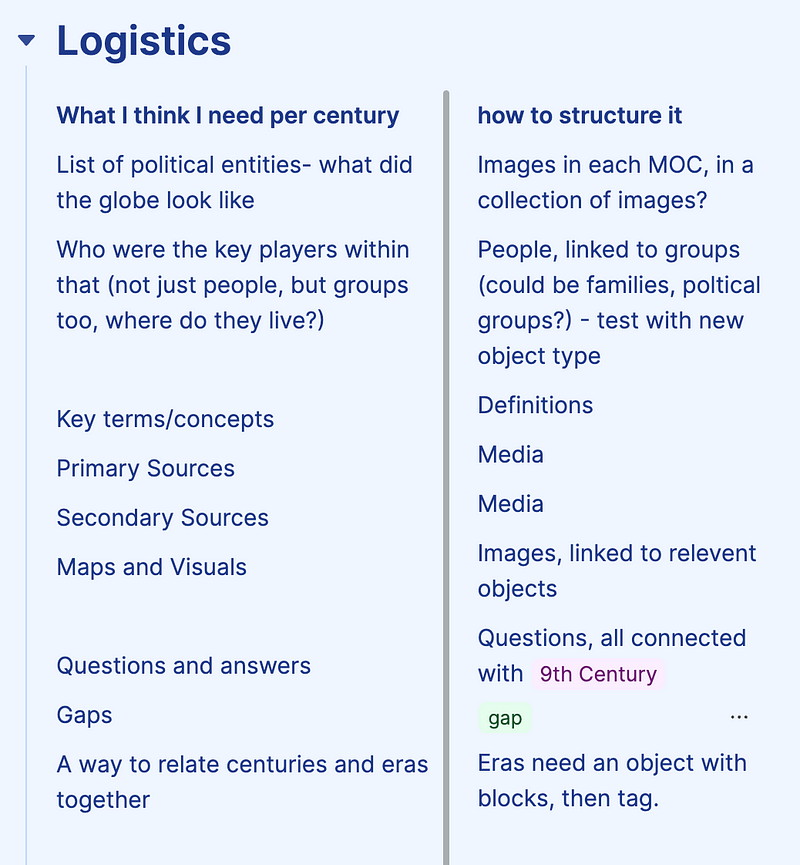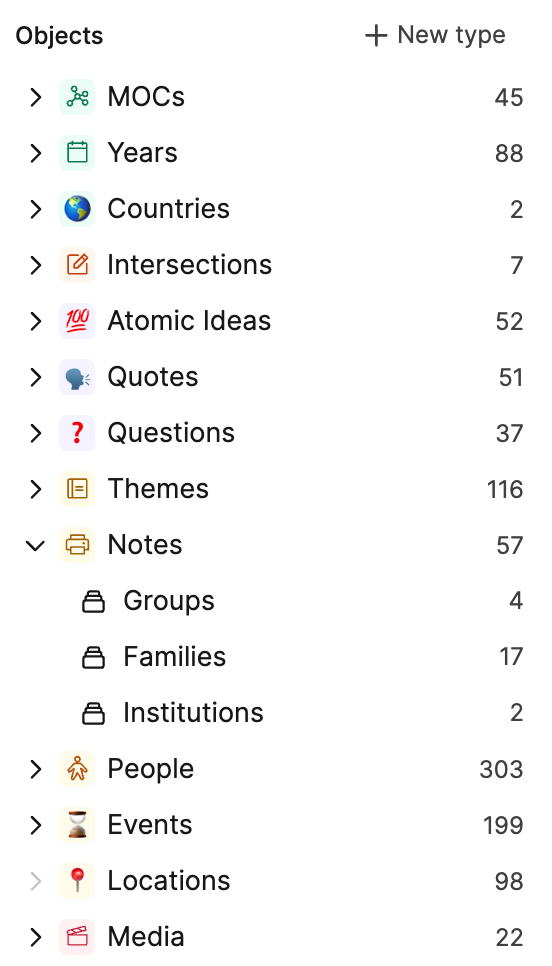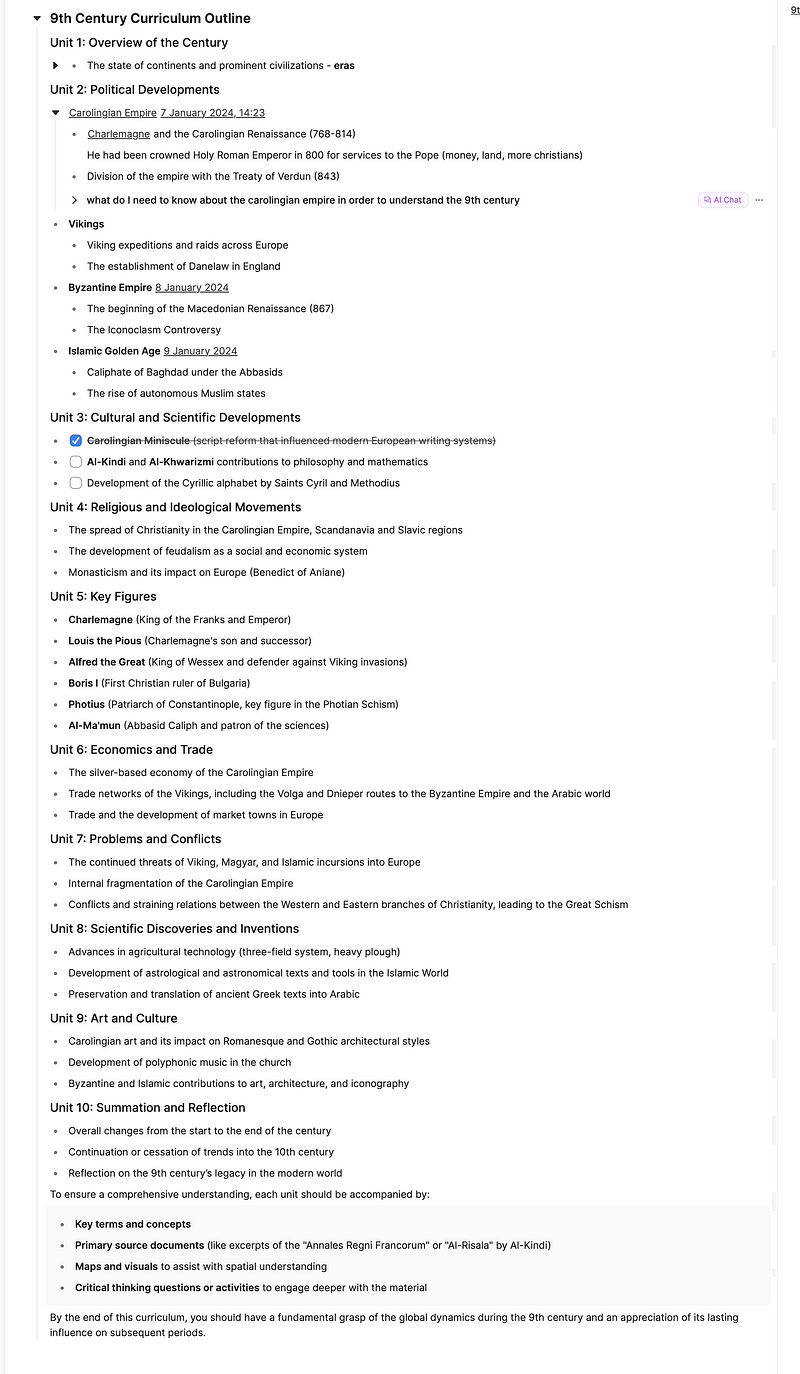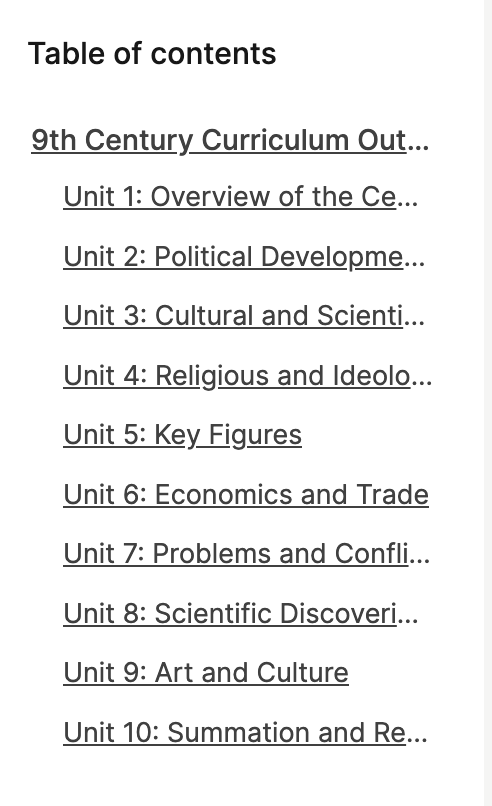My 2024 PKM Project: 12 Centuries in 12 Months
Twitter has been integral to my PKM and note-taking journey, and Stian Håklev’s recent tweet has sparked a new era which I’m thrilled to enter.
If you want to read Stian’s thoughts about this project and where it could go, I really recommend checking out his Tana Pub page and his Youtube video,
I am joining Stian on this journey and I honestly cannot wait: my 2024 PKM project is to learn 12 centuries of history in 12 months, beginning at the 9th century this month, and ending with the 20th century in December.
I knew I had to do this when his tweet made me the human manifestation of my favourite emoji, 🤩- timelines, people, events, and even maps are all things I think about a lot (and have written about in some way), and tying them together with a specific project is just what I needed.
So this is the intro post to what should be a year’s worth of specific PKM content, showcasing how I’m managing hopefully all aspects of this project in Capacities, and my broader digital systems too. I will still make other content but expect lots more of this.
Crucially, none of this content will be polished. I typically don’t post a piece until I’m sure I’m happy with it (hence why you haven’t seen any task management content for a long time), but I think for note-taking projects, it is useful to show how they are built bottom-up rather than forcing someone else’s structure onto your notes. It allows me to share some real life thinking behind why I do what I do, and why I choose the methods that I do. I hope this will be an enjoyable new angle to my content.
So why this challenge specifically?
I think this semi-structured approach is excellent: it gives me a framework for the year, but it’s open enough that I have a lot of flexibility within it, which is how it stays interesting.
I’ve also long been thinking about the relationship between arbitrary units of time and the complex web of people, events, themes and that are happening in spite of these time periods, which can often be viewed through eras. I’ve only explored this through personal journalling but now it’s time to bring history into it.
To explain further, I don’t think centuries alone are particularly meaningful. The start and end dates are products of the arbitrary constructs of time. The dawn of a new century didn’t set off a series of events. The events would have been set in motion by countless decisions made beforehand by countless actions. In other words, centuries are necessarily sequential, but the complex and interconnected topics, people and events discussed in the study of them are not. We need to look outside the neat divisions of a time period in order to achieve a deeper understanding of the material within it.
A networked note-taking app (Capacities) gives me the means to explore this, but working through century by century gives me a useful and necessary starting point to begin research.
How will I do this project?
Like Stian, I am looking at the 9th-20th centuries, one per month.
With such a huge project, I have decided to focus on some specific things this time round, I can honestly see myself doing this for multiple years, shifting focus each time.
I’m of course focusing on history, politics, and key figures and events within them, which is very much my normal practice. But I also want to pay attention to two other things.
- Scientific discoveries
- Daily lives of the people at the time, particularly of women.
I have always been a humanities girl, so I could not tell you the first thing about important scientific discoveries and I’d like to change that. I think rooting my research of this within its historical context immediately makes it more interesting to me as it’s more aligned with my interests.
I also know a lot about wars and conflict, but I’m increasingly interested in what women were doing at home and how that’s changed over time. For example, we know that the introduction of dishwashers and washing machines massively changed home life, what were some equivalent developments previously?
But I also think it’s important to be realistic with how large a task this is and how many different directions it could take. To this end, I’m prioritising learning about British history, and even more particularly Northern British history. I hope that I will be able to go on trips to visit places I hear about, which is something I’m increasingly passionate about where it’s possible to do so. I’ve also got a lot of existing notes on British history, so it makes sense to build on them first. However, prioritising them in no way means ignoring the rest of the world, that would actually hinder my understanding and is a generally bad idea.
The Note-taking side
Unsurprisingly I’ll be using Capacities to make all my notes!

I always start projects working within the structures I already have, only making changes when needed. This is the bottom-up approach to building systems and workflows and it ensures a) it works because it emerges from my needs and is crafted to meet them and b) I don’t spend weeks crafting systems I don’t use.
For me that meant sticking to the workflows I already have using the object types I already have. I’ll be following my my note-taking process in my main space. I think I’ll do an updated tour of my main Capacities space next week as it’s changed a bit since then.
When I start projects like this, I take 10 mins to work out what the project needs are and then I then map them onto my object types.
This thinking is nested in the logistics toggle:
On the left is what I want, and the right is what I have. Most things very easily mapped over.


I decided to add century tags as an organisational structure, and #gap to collect all the things I’m confused about. I’ll review it periodically either to determine if it’s required for understanding the current topics of research, or if it’s something I’ll pick up after this challenge. I can’t learn everything in 12 months.
Then I was thinking about how to communicate the relation between centuries and eras. A networked note-taking app is set up to do just that, but I was thinking more specifically in the context of how I want those relations to look in Capacities.
I definitely overthought this so I’ll skip straight to the result:
I will use the Map of Content object for both eras and centuries. It would follow my existing practice to give each era and century an equivalent tag. This is what I showed in my Map of Content video and it’s what I’ll continue with until I realise something doesn’t quite fit.
My map of content object type is where I put overarching topics and instead of filing the blocks with text and information, I mould it into a collection of links/sections/launchpads into the research I have about it. This research lives in other objects like people, events, locations etc.
This is exactly what I showed in this video:
I then added two new properties.
For navigational ease I added a property called ‘followed by’ where I just put the next century. I don’t know how often I’ll use that but for some reason I wanted it. I should have also put one called proceeded by shouldn’t I…
Anyway, next I added a select property where I’ll link the eras that were ongoing in a given century.
Whilst it’s obvious that the eras will be referenced within the century page anyway, I’m hoping that having this information in the properties will one day allow me to form a sort of timeline.
This aims to somehow combine the arbitrary time periods I’ve mentioned before with the continuous messy nature of history. I have no idea how that will actually translate into notes, but as mentioned, this is something I’ve been thinking about for months and don’t need to be defined by the end of 2024. It’s a life goal.

Where to start?
So at this point in the set up, I knew what I wanted my notes and Capacities structure to look like. Then it was time to define the things I need to learn, because I seriously know nothing about the 9th century. I asked Capacities’ AI assistant to make me a curriculum.
I did this prompt for each of the 12 centuries and copied that into my Capacities pages:
I’m doing a project where I learn about 12 centuries (9th-20th) of world history (on a very basic level) in one year. Give me an outline for a 9th century curriculum. What key players, events, countries, politics, theories, problems, scientific discoveries etc do I need to know about?
This gave me a place to start. It also laid it out very nicely which automatically made an easy to navigate table of contents in the right sidebar.


The first unit was just an overview of what I will learn about, so I went straight to unit 2. When I have learned about each thing, then I can make a summary of each era in its own Map of Content, thus completing unit 1.
I really liked this AI approach because I struggle with starting tasks when there’s a lot of choice (if I know nothing but it’s my goal to know everything, how can I possibly choose which topic to start on?). This curriculum allowed me just to start, so I looked at the Carolingian Empire over the weekend and it was so fun.
To research these things, I’m mainly using course books from Wondrium courses which are academic-lead courses on literally so many topics. There are loads of the medieval world and I have been ready lots of them just as far as the 9th century to get started. I also have some other books and this website (link below) which is a new find… I’m obsessed.
I talk more about all of this in a Youtube video:
So, I think that’s everything for this intro post. Let me know if there’s any specific content you’d like about it, otherwise just expect some videos and posts about it over the course of this year 🙂
If you’re interested in this project, absolutely give Stian’s Tana Pub page a read, it’s a fascinating read that just made me even more excited.
Also if you’re interested in these more niche PKM topics, they’re typically what I explore in my newsletter which you can sign up to here: www.pkmbeth.com






